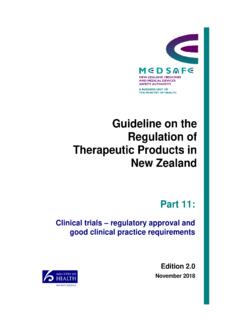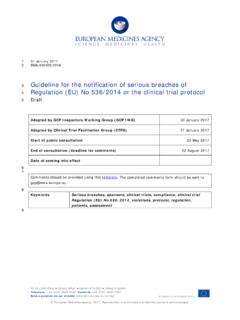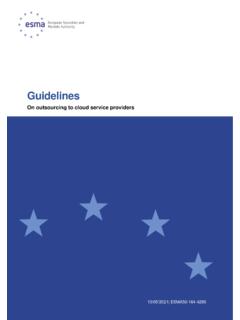Transcription of Guideline on the scientific application and the practical ...
1 25 February 2016. EMA/CHMP/509951/2006, Committee for Medicinal Products for Human Use Guideline on the scientific application and the practical arrangements necessary to implement Commission Regulation (EC) No 507/2006 on the conditional marketing authorisation for medicinal products for human use falling within the scope of Regulation (EC) No 726/2004. CHMP discussion July 2006. Adopted by CHMP for release for consultation 14 December 2006. End of consultation (deadline for comments) 31 March 2007. Drafting of revision 1 of the Guideline January May 2015. Consultation with PRAC, CAT, COMP, PDCO June 2015. Adopted by CHMP for release for public consultation 23 July 2015.
2 Start of public consultation 27 July 2015. End of consultation (deadline for comments) 30 September 2015. Receipt of a favourable opinion of the European Commission 22 February 2016. Final Guideline adopted by the CHMP 25 February 2016. Date for coming into effect 1 June 2016. 30 Churchill Place Canary Wharf London E14 5EU United Kingdom Telephone +44 (0)20 3660 6000 Facsimile +44 (0)20 3660 5555. Send a question via our website An agency of the European Union European Medicines Agency, 2016. Reproduction is authorised provided the source is acknowledged. Guideline on the scientific application and the practical arrangements necessary to implement Commission Regulation (EC) No 507/2006 on the conditional marketing authorisation for medicinal products for human use falling within the scope of Regulation (EC) No 726/2004.
3 Table of contents Executive summary .. 3. 1. Introduction (background) .. 3. 2. 3. 3. Legal basis .. 3. 4. Granting of a conditional marketing authorisation .. 3. Applicant's request for a conditional marketing authorisation .. 3. Justification that the medicinal product falls within the scope of the conditional marketing authorisation .. 4. Fulfilment of the requirements for conditional marketing authorisation .. 5. Agency advice prior to submission of a request for conditional marketing authorisation .. 10. CHMP proposal for a conditional marketing authorisation .. 10. CHMP assessment of a request for conditional marketing authorisation.
4 11. Information included in the summary of product characteristics and package leaflet .. 11. Periodic safety update reports .. 11. 5. Renewal of a conditional marketing 12. Documents to be submitted .. 12. General requirements .. 12. Requirements for the interim report on the specific obligations .. 13. 6. Marketing authorisation not subject to specific obligations .. 14. Abbreviations .. 16. References .. 16. EMA/CHMP/509951/2006, Page 2/16. Executive summary This Guideline has been developed in order to provide advice on the scientific application and the practical arrangements necessary to implement the legal provisions on the conditional marketing authorisation, taking into account the experience gained so far.
5 1. Introduction (background). According to Article 14(7) of Regulation (EC) No 726/2004, following consultation with the applicant, an authorisation may be granted subject to certain specific obligations, to be reviewed annually by the Agency. The list of these obligations shall be made publicly accessible. By way of derogation, such authorisation shall be valid for one year, on a renewable basis. This provision for a conditional marketing authorisation is further defined in Commission Regulation (EC) No. 507/2006. Conditional marketing authorisation, in line with the defined scope and criteria and in the interest of public health, is usually appropriate for products where the benefit-risk balance is such that the immediate availability outweighs the limitations of less comprehensive data than normally required, medicines with an established potential to address an unmet medical need.
6 When references in this Guideline are made to the assessment activities conducted by the CHMP, for advanced therapy medicinal product they should be read as referring also to the assessment conducted by the Committee for Advanced Therapies. 2. Scope This Guideline addresses the granting and renewal of conditional marketing authorisations, as well as the subsequent granting of marketing authorisations not subject to specific obligations following their completion. 3. Legal basis The legal basis for this Guideline is Article 11 of Commission Regulation (EC) No. 507/2006 on the conditional marketing authorisation for medicinal products for human use falling within the scope of Regulation (EC) No 726/2004.
7 4. Granting of a conditional marketing authorisation Applicant's request for a conditional marketing authorisation A conditional marketing authorisation may be requested by the applicant or proposed by the CHMP. The applicant is invited to notify the EMA about its intention to request a conditional marketing authorisation as part of the letter of intent to be sent to the EMA in advance of the submission of the application for marketing authorisation. The applicant may present a request for a conditional marketing authorisation at the time of the application for marketing authorisation. A request for conditional marketing authorisation shall be submitted in module of the EU-CTD.
8 EMA/CHMP/509951/2006, Page 3/16. The request should consist of justifications to show that the medicinal product falls within the scope of the conditional marketing authorisation Regulation (Article 2 of Commission Regulation (EC) No 507/2006) and that the requirements for conditional marketing authorisation are fulfilled (Article 4 of Commission Regulation (EC) No 507/2006), together with the applicant's proposal for completion of ongoing or new studies and, if applicable, also specific proposals for collection of pharmacovigilance data. The request may cross-refer to specific parts of the application . Upon receipt of a valid application containing a request for conditional marketing authorisation, the EMA will inform the Commission that an application for a conditional marketing authorisation has been submitted (Article 3 of Commission Regulation (EC) No 507/2006).
9 Justification that the medicinal product falls within the scope of the conditional marketing authorisation The applicant should justify that the medicinal product falls within the scope of a conditional marketing authorisation. The categories of medicinal products that fall within the scope of the conditional marketing authorisation are defined in Article 2 of Commission Regulation (EC) No 507/2006. These are products for human use falling under Article 3(1) and (2) of Regulation (EC) No 726/2004, and belonging to at least one of the following categories: 1. Seriously debilitating diseases or life-threatening diseases The severity of the disease, , its seriously debilitating, or life-threatening nature needs to be justified, based on objective and quantifiable medical or epidemiologic information.
10 Whereas a life-threatening disease is relatively easy to describe based on figures of mortality and life expectancy, justifying that a disease is seriously debilitating will have to consider morbidity and its consequences on patients' day-to-day functioning. For a disease to be considered seriously debilitating it would need to have a well-established major impact on patients' day-to-day functioning either already early in the course of the disease, or in the later stages. These aspects should be quantified in objective terms, as far as possible. Furthermore, serious debilitation, or fatal outcome should be a prominent feature of the target disease and therapeutic indication, affect an important portion of the target population.












